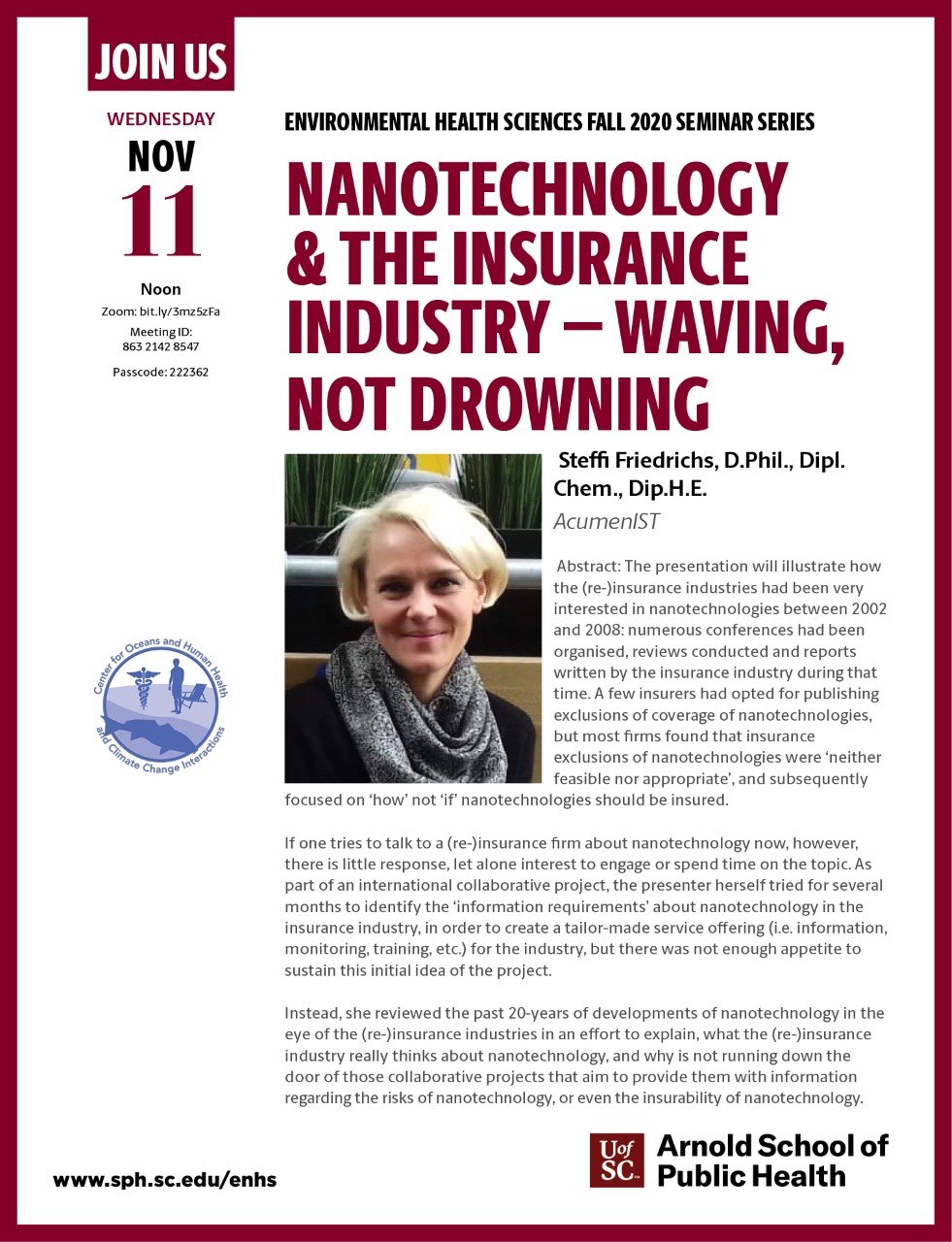‘[I]nsurance is the institution of governance beyond the state […]’
[R. V. Ericson, A. Doyle, and D. Barry ‘Insurance as Governance’, 2003]
Based on an in-depth analysis conducted for the Gov4Nano Project, Dr Steffi Friedrichs delivered a seminar entitled ‘Nanotechnology & the Insurance Industry’ as part of the Environmental Health Sciences Seminar Series (Fall 2020) at the University of South Carolina.

The lecture outlined the role that the (re-)insurance industry played in the emergence and advancement of new technologies, and summarised some of the basic underlying principles (and limitations) of the industries’ activities with regard to (new) technologies:
‘[I]nsurance is crucial for governing the everyday world of safety and security […]’
[R. V. Ericson and A. Doyle ‘Uncertain Business: Risk, Insurance, and the Limits of Knowledge’, 2004]
The insurance industry acts as an agent for individually insured companies, who would otherwise be helpless against the risk:
- Risk are framed as calculable: actuarial analysis (i.e. statistics-based ideas of normalcy) – what is ‘normal’ also becomes the moral norm.
- The insured are ‘pooled’ together according to their risk profiles: costs of prevention must be lower than the expected losses.
- BUT: new technologies introduce changes to the dimensions of injury and damage: this ‘risk of change’ gives rise to an underlying risk of ‘control(un)ability’.
Dr Friedrichs illustrated how the emergence of new technologies presented opportunities for the (re-)insurance industry:
In the case of new technologies, the ‘scientific and technical knowledge for actuarial precision is limited and equivocal’ [Ericson et al., 2003]; nevertheless, many insurers underwrite the risks of new technologies anyway, because they regard the economic logic as superior to the scientific logic of risks [Lippert & Jackson, 2006].
[…] many insurance firms frequently regard new technologies as opportunities to inhabit niche markets to insure against new and potentially catastrophic kinds of damage.
[S. Friedrichs after Lippert & Jackson, 2006]
The (re-)insurance industry’s intentions vis-à-vis newly emerging technologies amounted to three categories of ‘opportunism’:
… the GOOD, who represented the majority of (re-)insurance firms that issues public statements concerning nanotechnology, which typically noted that ‘[…] it seems neither feasible nor appropriate to start a debate about a general exclusion of nanotechnologies from the insurance coverage today.’ [Allianz Group, et al., 2005]
… the BAD, who were embodies by firms that published nanotechnology-specific exclusions (e.g. (a) September 2008: US insurer Continental Western Insurance Group issued what appeared to be one of the first nano-specific commercial insurance exclusions, and (b) November 2008: US Insurance Services Office Inc.: exclusion of coverage for bodily injury, property damage, and personal and advertising injury ‘related to the actual, alleged or threatened presence of or exposure to ‘nanotubes’ or ‘nanotechnology’ in any form, or to harmful substances emanating from ‘nanotubes’ or ‘nanotechnology.’). Such blanket exclusions turned out to be somewhat ignorant of the scientific principles of the technology they are aiming to exclude in that they cannot be enforced without also excluding other technologies in their wake.
… the UGLY, who – unlike the BAD, who merely wished to avoid large costs for themselves – were after a quick extra profit by offering nanotechnology-specific insurance policies (e.g. Nanotechnology Liability Insurance (Sadler & Co. Nanotechnology product liability insurance [Online]. – https://www.products-liability-insurance.com/nanotechnology-coverage/ )) or special ‘Nanotechnology Insurance Policy’ (e.g. La Playa Limited Nanotechnology Insurance [Online]. – https://laplayainsurance.com/uk/science-technology/nanotechnology-insurance/). It remains unclear, what such insurance policies consist of in detail.
The longitudinal analysis conducted by Dr Friedrichs showed that the (re-)insurance industry had been concerned with nanotechnologies over the best part of the past 20 years; most activities (i.e. analyses, reports, stakeholder dialogues events) took place between 2002 and 2006.
The 2019 report of the ‘Emerging Risk Initiative’ (ERI), a pre-competitive joint effort of several (re-)insurance firms, categorised nanotechnology as a ‘medium risk’, for which the first significant impact could be expected within 1-5 years; in the ERI’s Risk Radar plot, nanotechnology sits between ‘genetically modified organisms’ (small risk; first significant impact: 5-10 years) and ‘pandemics’ (high risk; first significant impact: 1-5 years) [CRO Forum, 2019].
Follow this link to read the public Fact Sheet of AcumenIST’s report on ‘The Information Needs of the (Re-)Insurance Industry’ (the full report is confidential and available to Gov4Nano partners only).
- Allianz Group and OECD ‘Opportunities and risks of Nanotechnologies Report in co-operation with the OECD International Futures Programme’, 2005.
- CRO Forum ‘Emerging Risks Initiative Major Trends and Emerging Risk Radar’, 2019.
- R. V. Ericson and A. Doyle ‘Uncertain Business: Risk, Insurance, and the Limits of Knowledge’, 2004.
- R. V. Ericson, A. Doyle and D. Barry ‘Insurance as Governance’, 2003. – DOI: 10.3138/9781442676220.
- I. Lippert and H. Jackson ‘The Insurance Industry and Nanotechnology Risks’, 2006.








